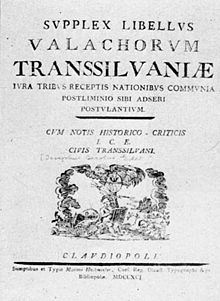Supplex Libellus Valachorum
This article uses bare URLs, which may be threatened by link rot. (September 2021) |

Supplex Libellus Valachorum Transsilvaniae (Latin for Petition of the Romanians of Transylvania) is the name of two petitions sent by the leaders of the ethnic Romanians of Transylvania to the Holy Roman Emperor Leopold II, demanding equal political rights with the other ethnicities of Transylvania and a share of the Transylvanian Diet proportional to their population.
The first Supplex was sent in March 1791 by , the Greek Catholic bishop of Oradea, to the State Council of Vienna. The second Supplex, a largely expanded and argumented version of the first, was brought before the Imperial Court of Vienna on March 30, 1792, by Ioan Bob, Greek Catholic bishop of Blaj, and by , Orthodox bishop of Transylvania.
The demands in the petition, according to the researches of David Prodan, were largely based on the Declaration of the Rights of Man and of the Citizen of Revolutionary France, and it also included an essay reviewing historical reasons (such as references to a Roman Dacia-Romanian continuity[citation needed]) as well as statistics about the Romanians (who made up approximately 55% of the population of Transylvania). According to some more recent researches, the argumentation of the Supplex Libellus Valachorum based on the ideas of natural law as well as on the Hungarian feudal judicial argumentation.[1]
The document was drafted by the most important representatives of the Romanian nation of Transylvania (which were, for the most part, clerics of the Romanian Greek Catholic Church): Samuil Micu, Petru Maior, Gheorghe Șincai, , , Ion Budai-Deleanu, etc. The petition was signed in the name of the Romanian nation by its free categories: Clerus, Nobilitas, Civicusque Status Universae Nationis in Transilvania Valachicae.
The Supplex was rejected and, as such, the status of the Romanians remained the same. Several such petitions were issued in the following decades, and they all met with the same reaction. Another major petition, the Transylvanian Memorandum, was drafted a century later (in 1892, following the new circumstances after the 1848 Revolution and the Ausgleich), but its authors were sent to prison for treason.
References[]
Sources[]
- , Supplex Libellus Valachorum, Bucharest, 1948.
- Aron Kovacs, Continuity and Discontinuity in Transylvanian Romanian Thought: An Analysis of Four Bishopric Pleas from the Period between 1791 and 1842. In.: Hungarian Historical Review 5, no. 1 (2016): 46–72.
External links[]
| Wikimedia Commons has media related to Supplex Libellus Valachorum Transsilvaniae. |
- 1791 in Europe
- 18th century in the Habsburg Monarchy
- Age of Enlightenment
- Transylvanian School
- History of Transylvania (1683–1848)